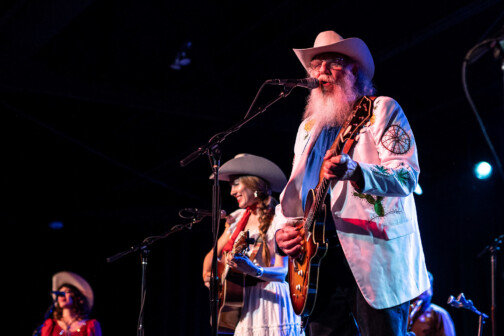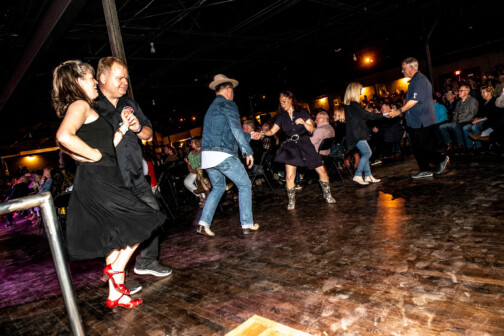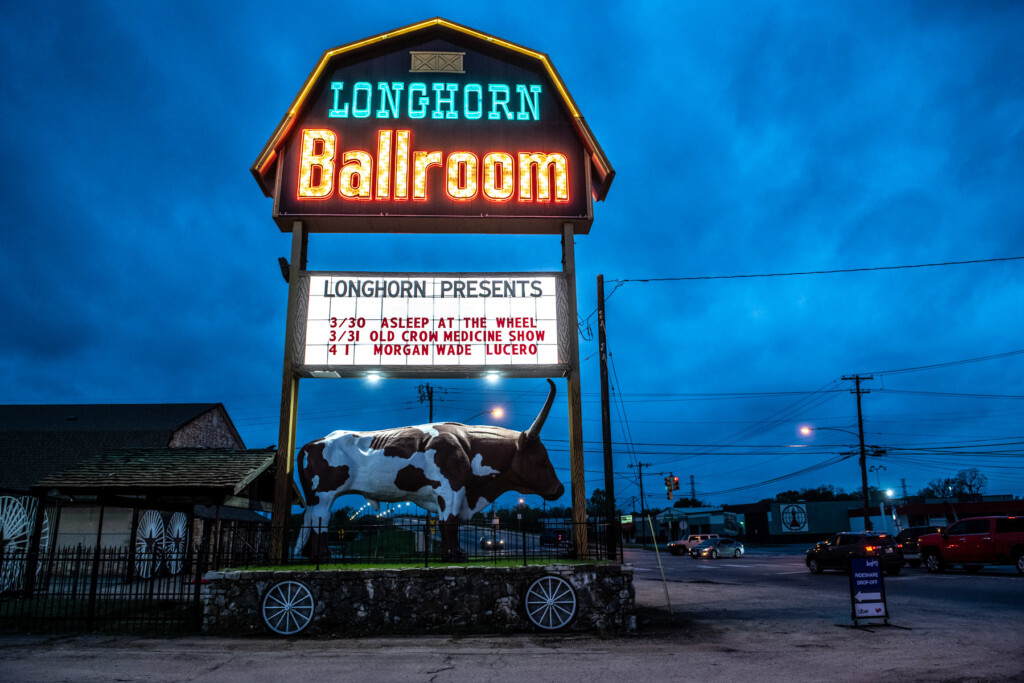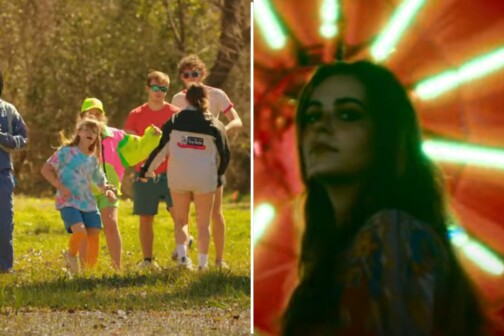Ray Benson first performed at the Longhorn Ballroom 49 years ago with his band, Asleep at the Wheel. His return on Thursday night marked the official reopening of the historic Cedars neighborhood music venue by bringing it back to its roots in Western swing.
Benson, the band’s leader, is the only original member of Asleep at the Wheel remaining in the outfit. Back then, he and his friends were young hippies enamored with the genre, committed to a life of keeping the music of its forebearers—undisputedly Bob Wills and his Texas Playboys—alive for new generations of two-steppers and waltz-ers. After all, the Dallas venue was originally named Bob Wills’ Ranch House when it first opened in 1950.
Hours before Benson took the stage, the man responsible for the renovation bounced between a parking lot full of elected officials, media, musicians, and other guests. Edwin Cabaniss brought the far smaller Kessler Theater back to life in Oak Cliff in 13 years ago. He reopened the Heights Theater in Houston in 2016. The Longhorn—with a capacity of 2,100, about seven times the size of the Kessler—is by far his most ambitious effort yet.
It took over a year to get to this point, which included $4.1 million in city incentives and convincing the Council to pass a zoning change.
“I’m tired of talking about it,” he said to someone in the parking lot on Thursday morning before the press conference. “I wanna show it.”

The Longhorn’s stage is perhaps the most impressive of all Dallas venues of this size, wide enough that it runs the length of the sunken dance floor. The Longhorn was basically a big, open barn; now, suites flank the wooden floor, framing sight lines while separating the activity at the bar and restrooms from the show itself.
The three weekend concerts were all heavily country. Asleep at the Wheel kicked things off, Old Crow Medicine Show and Joshua Ray Walker followed on Friday, and Lucero and Morgan Wade closed the weekend on Saturday. (The recently retired Robert Earl Keen was a surprise guest during Old Crow Medicine Show’s Friday set, adding to the excitement of Dallas’ newest venue.)
The sound has been completely overhauled, and Morgan Wade’s sold-out Saturday night performance was so loud and clear that it likely served as a warning to anyone who plans to return to see legendary noise rockers Dinosaur Jr. later in the month: bring ear plugs, just in case. Indeed, the booking will broaden in the coming months. Cabaniss has already added the Polyphonic Spree and Snarky Puppy to bills later this spring. (Although Emmylou Harris has the honor of the venue’s first two-night stand since its reopening.)
But Asleep at the Wheel was the only choice for the grand reopening. On stage, Benson referred to the Longhorn Ballroom as “the Carnegie Hall of Western Swing.” But the venue’s history extends well beyond the genre.
After Wills, The Longhorn was briefly managed by Jack Ruby about a decade before he shot Lee Harvey Oswald. (You can find his beige suit in a museum case near the back bar.) But under the eventual management of Dewey Groom (whose family was in attendance Thursday), it would host every iteration of Texas country (including Willie and Waylon and Jerry Jeff), Nashville country (Loretta, Tammy, and George), soul, blues, and R&B (Al Green, James Brown, B.B. King, and Otis Redding), and punk (Patti Smith and the Sex Pistols). All their photos are framed in the entryway, alongside artists as varied as the Flaming Lips to Little Richard and Ray Charles.
During a soft opening on Monday for friends and family, literally only hours after the city granted Cabaniss the certificate of occupancy, the Bastards of Soul played two 45-minute sets. The 77-year-old soul legend Bobby Patterson sat in on a few songs, nodding to the venue’s history of blues and funk.
“It wasn’t just country and western here,” Cabaniss told South Oak Cliff Councilwoman Carolyn King Arnold while the two were admiring James Brown’s teal-and-gold robe. It is among about two dozen framed cases of memorabilia belonging to artists who played here.
Four days after the soft opening, Asleep at the Wheel kicked off the venue’s new era with crowd-pleasing renditions of “Miles and Miles of Texas” and “Get Your Kicks On Route 66.” They were fitting choices to set the mood. At its core, Western Swing is like laying a road map on the hood of a Lincoln and penciling round trip directions from jazz to country.
But it was the third song of the band’s set that would sum up what the night meant to everyone involved. Written by Waylon Jennings, “Bob Wills Is Still the King” is the most known song off Jennings’ seminal live album “Waylon Live,” in which, in 1973, he claims he wrote the slightly self-deprecating song “on a plane between Dallas and Austin.” The lyrics—“It don’t matter who’s in Austin, Bob Wills is still the king”—will always hit harder in Dallas, but in the Longhorn Ballroom, with some of Wills’ family in attendance, it just felt right that Benson was the one who delivered the lines.

Jennings is an important part of the Longhorn’s history, having first played in 1968 before becoming a regular. His famed “Number 3” Fender Telecaster is in a glass case behind the suites, which Cabaniss acquired at auction. Jennings played this exact guitar throughout the 1990s, strapped across his chest during more than 100 Highwaymen gigs until he retired in 1997.
Cabaniss plans to take it to the man who made the guitar, Michael Stephens, and have him tune it in the Far West Texas town of Alpine, where he lives. After it returns to the Longhorn, Cabaniss says the right band will be allowed to bring it onstage.
“Let’s say your song is somewhere between Jennings or Jones,” he says. “We can take this guitar out of the case, plug it in, and play. They only need my permission.”
The Longhorn also has Bob Wills’ 1937 fiddle amp, which needs a little bit more love than a quick tune. But after it’s fixed up, “Ray Benson can take it up on stage,” Cabaniss said.
The venue’s future will likely look to replicate its musically eclectic 1970s era, but Thursday night was about Wills as much as it was anything else. For most of the second half of the 1940s, being a member of the Texas Playboys playing under the “King of Western Swing” was one of the most lucrative jobs in music. To take the stage with Wills, you had to keep up.
Asleep at the Wheel carries on that tradition. Benson is the show’s tour guide as much as a musician, sprinkling Texas references through a medley of big band sounds; the saxophone player is a clarinet player and a guitar player, the keyboard player is an accordion player, two fiddle players are better than one, and the slide steel guitar player could hang with anyone either side of the Red River.
Western swing isn’t about compartmentalizing music. It’s about adding its elements together. True to form, the show’s featured acts, Joshua Hedley and Brennen Leigh—two successful and acclaimed solo acts in their own right—were not given opening slots. They were on stage with Asleep at the Wheel for every single song, Hedley on the fiddle and Leigh on guitar.
Benson led the audience through a shuffle of songs recorded by Wills, Leigh, Hedley, Willie Nelson, Lefty Frizzell, George Strait, and even a beautiful, melodic rendition of “When You Wish Upon A Star” by Hedley that could have tucked the entire audience into bed before Benson jolted them back awake with a double speed version of “Hot Rod Lincoln.”
The sound and sightlines were as exceptional as concertgoers have come to expect from Cabaniss’ Kessler Theater in Oak Cliff, a considerably smaller venue. The pole in front of the stage that held up the roof from the floor was removed and replaced with a 60-foot steel beam that rests just below the ceiling, out of the view of the concertgoer.
Cabaniss said these additions were a must: “sound and lights and sight lines are what we’re known for. It’s gotta be something special for the patron.” About the sound: The tin roof is coated from the inside with a type of insulation called open cell spray foam. “It takes away a lot of the bounce,” Cabaniss said, which is important for a room this large and cavernous. The venue had to pull up the original wood on the dancefloor, but pieces of it were cut into rectangles and mounted on a short wall between the suites and general admission. In between each piece of wood is a fiberglass liner that further diffuses sound.
The reborn Longhorn is also living history. Pipes that fed the sprinklers burst at one point during construction, which forced Cabaniss and the crew to remove the drywall near the back bar. They found a portion of a mural that not even the Groom family knew existed: a cowboy surging forward on a horse, past a landscape of cacti and cows. It was preserved all these years because it was covered up; Cabaniss said the mural spanned the length of the venue when Bob Wills ran the joint.
When all the musicians with Asleep at the Wheel took a collective bow and walked off stage, the audience immediately chanted for an encore. These chants were accented by the booming sound of hundreds of cowboy boots stomping in unison. The kind of sound that reverberates even more powerfully in a 72-year old barn that has seen as many musical legends as any building in the state of Texas. For those few seconds, it might as well have been 1955. Or 1968. Or 1976.
The doors to the past had been opened. Under Cabaniss’ management, he has assured, they’re staying open.
Authors

Jonny Auping








